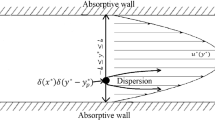Abstract
A shallow water flow model and a pollutant transport model were developed, and this study highlighted the practical applications of the coupled flow and dispersion models in terms of general properties. The flow model used the Petrov–Galerkin method in which the test functions are deformed by the current direction to introduce balancing diffusion only in the flow direction. The developed flow model was coupled to the pollutant transport model with a spatially varied dispersion tensor to demonstrate soluble constituent mixing. Three applications were considered to test the model performance under various Fr numbers. In the first application, the flow passing through a flume with an abrupt sidewall expansion was considered, and the model prediction was verified by experimental values, focusing on recirculation and the pollutant cloud trap. In the second and the third applications, the trans-critical and super-critical flow regimes evolved in non-uniform channels with an expanding or converging sidewall were reproduced, and pollutant mixing by a spatially varied dispersion tensor was investigated.









Similar content being viewed by others
References
Alavian V (1986) Dispersion tensor in rotating flows. J Hydraul Eng 112:771–777
Aliabadi S, Johnson A, Zellars B (2002) Parallel simulation of flows in open channels. Future Gen Comput syst 18:627–637
Brooks AN, Hughes TJR (1982) Streamline upwind/Petrov–Galerkin formulations for convection dominated flows with particular emphasis on the incompressible Navier–Stokes equations. Comput Methods Appl Mech 32:199–259
Causon DM, Mingham CG, Ingram DM (1999) Advances in calculation methods for supercritical flow in spillway channels. J Hydraul Eng 125:1039–1050
Duan JG (2004) Simulation of flow and mass dispersion in meandering channels. J Hydraul Eng 130:964–976
Elder JW (1959) The dispersion of marked fluid in turbulent shear flow. J Fluid Mech 5:544–560
Fischer HB, List EJ, Koh RCY, Imberger J, Brooks NH (1979) Mixing in inland and coastal waters. Academic Press, London
Heinrich JC, Pepper DW (1999) Intermediate finite element method—fluid flow and heat transfer applications. Taylor & Francis, London, p 238
Hervouet JM (2007) Hydrodynamics of free surface flows: modelling with the finite element method. Wiley, New York
Hughes TJR (1987) Recent progress in the development and understanding of SU/PG methods with special reference to the compressible Euler and Navier–Stokes equations. Int J Numer Methods Fluid 7:1261–1275
Ippen AT, Dawson JH (1951) High velocity flow in open channels: design of channel contractions. Trans ASCE 116:326–346
Khalifa A (1980) Theoretical and experimental study of the radial hydraulic jump. Ph. D. dissertation, University of Windsor, Windsor, Ontario
Lee ME, Kim GW (2012) Influence of secondary currents on solute dispersion in curved open channels. J Appl Math. doi:10.1155/2012/781695
Lee ME, Seo IW (2010) 2D finite element pollutant transport model for accidental mass release in rivers. J Civil Eng 14:77–86
Letter JV, Donnel BP (2005) Users guide for RMA4 version 4.5. Engineer Research and Development Center, US Army
Liang D, Lin B, Falconer RA (2007) A boundary-fitted numerical model for flood routing with shock-capturing capability. J Hydrol 332:477–486
Rutherford JC (1994) River mixing. Wiley, Chichester
Sabbagh-Yazdi SR, Jamshidi M (2013) Depth-averaged hydrodynamic model for gradual breaching of embankment dams attributable to overtopping considering suspended sediment transport. J Hydraul Eng 139:580–592
Scott, JA (2004) A state-of-the-art frontal solver for finite-element application. Technical report RAL-TR-2004-026, Rutherford Appleton Laboratory
Seo IW, Lee ME (2006) Development of 2D advection-dispersion model with dispersion tensor considering velocity field. KSCE 26:171–178 (in Korean)
Seo IW, Song CG (2010) Specification of wall boundary conditions and transverse velocity profile conditions in finite element modeling. J Hydrodyn 22:633–638
Seo IW, Song CG (2012) Numerical simulation of laminar flow past a circular cylinder with slip conditions. Int J Numer Methods Fluid 68:1538–1560
Seo IW, Lee ME, Baek KO (2008) 2D modeling of heterogeneous dispersion in meandering channels. J Hydraul Eng 134:196–204
Seo IW, Kim YD, Song CG (2014) Validation of depth-averaged flow model using flat-bottomed benchmark problems. Sci World J. doi:10.1155/2014/197539
Song CG, Seo IW, Kim YD (2012) Analysis of secondary current effect in the modeling of shallow flow in open channels. Adv Water Resour 41:29–48
Steffler PM, Blackburn J (2002) Introduction to depth averaged modeling and user’s manual. River2D Two-dimensional depth averaged model of river hydrodynamics and fish habitat, University of Alberta, 76
Takase S, Kashiyama K, Tanaka S, Tezduyar TE (2010) Space–time SUPG formulation of the shallow-water equations. Int J Numer Methods Fluid 64:1379–1394
Vreugdenhil CB (1994) Numerical methods for shallow-water flow. Kluwer Academic Publishers, Amsterdam
Weiyan T (1992) Shallow water hydrodynamics-mathematical theory and numerical solution for a two-dimensional system of shallow water equations. Elsevier, Amsterdam
Xie BL (1996) Experiment on flow in a sudden-expanded channel, technical report. Wuhan University of Hydraulic and Electric Engineering, China
Younus M, Chaudhry MH (1994) A depth-averaged turbulence model for the computation of free-surface flow. J Hydraul Res 32:415–444
Zounemat-Kermani M, Sabbagh-Yazdi SR (2010) Coupling of two- and three-dimensional hydrodynamic numerical models for simulating wind-induced currents in deep basins. Comput Fluids 39:994–1011
Acknowledgments
This research was supported by a grant ‘Development of the Evaluation Technology for Complex Causes of Inundation Vulnerability and the Response Plans in Coastal Urban Areas for Adaptation to Climate Change’ (MPSS-NH-2015-77) from the Natural Hazard Mitigation Research Group, Ministry of Public Safety and Security of Korea, and by Basic Science Research Program through the National Research Foundation of Korea (NRF) funded by the Ministry of Science, ICT and Future Planning (NRF-2014R1A1A1002204).
Author information
Authors and Affiliations
Corresponding author
Ethics declarations
Conflicts of interest
The authors declare no conflict of interest.
Rights and permissions
About this article
Cite this article
Park, I., Seo, I.W., Do Kim, Y. et al. Flow and dispersion analysis of shallow water problems with Froude number variation. Environ Earth Sci 75, 120 (2016). https://doi.org/10.1007/s12665-015-4928-z
Received:
Accepted:
Published:
DOI: https://doi.org/10.1007/s12665-015-4928-z




